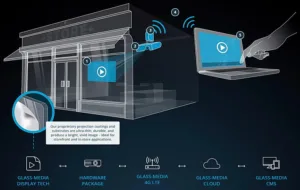This section of the IL and Startup Pavilion story will deal with customer-oriented display technologies. This, of course, is only a subset of all customer-oriented display technologies at NRF. Others, presented by more established companies, will be described in the appropriate sections of the NRF event report. As already mentioned, there will be no coverage of generic digital signage – that comes after ISE in February.
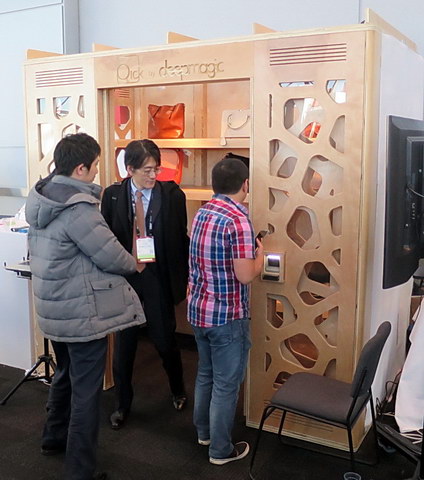 The Deep Magic kiosk allows unattended sales of a variety of items, including high-value items. (Credit: M. Brennesholtz)
The Deep Magic kiosk allows unattended sales of a variety of items, including high-value items. (Credit: M. Brennesholtz)
Deep Magic is a spin-out of New York University with Davi Geiger, NYU Professor of Computer Science and Neural Science, as Co-founder and Chief Scientist. Deep Magic was showing a walk-in kiosk for unattended sales. Insert your credit card and the kiosk door opens, allowing you and your friends to walk in. Take what you want, it is all recorded on video cameras and analyzed by AI. When you leave, anything you or your friend takes is charged to your credit card.
Geiger explained to me that currently there were two cameras in the kiosk and that provided sufficient coverage overlap to make sure anything taken was charged and nothing left behind was charged to the credit card. He added that no RFID tags were used or needed – it was all done by the vision system. I question the reliability of a two-camera system, especially for items on the lower shelf or when a second person in the kiosk can block the view of one camera. Professor Geiger admitted there was additional development work needed but he expected the first field installation of the system to happen in the next couple of months.
Glass Media provides a store-front rear-projection system based on a proprietary screen design and a laser-phosphor projector. (Source: Glass Media)
Glass Media was in the Innovation Lab showing their rear-projection system for store windows. The key to their system was what Daniel Black, Founder and CEO, called a “LCD screen” that was (nearly) transparent when looking straight through but a diffusing off axis-screen for an off-center projector. Details on the screen are not available, but he said it is available in both front and rear projection versions. Glass Media can supply all the hardware and software a retailer needs from the display system through the content management system (CMS). Glass Media did not have a demonstration system in the Innovation Lab which is probably just as well. The very high light levels in the area were very unfriendly for the other projection-based applications on display.
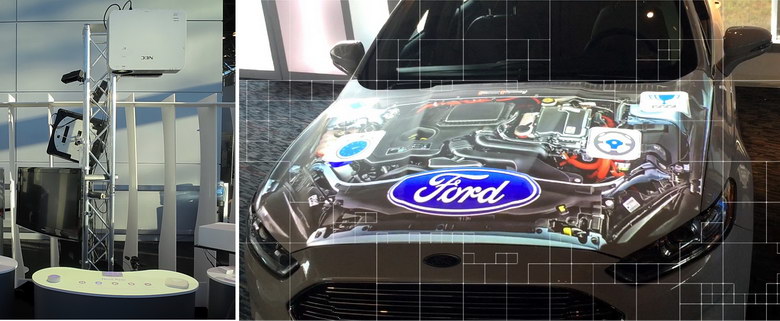 Left: Spacee projection-based Mixed Reality demo at NRF. Right: Spacee system using the hood of a car as an interactive touch screen to explain the engine features. (Credit: Left, M. Brennesholtz; Right, Spacee)
Left: Spacee projection-based Mixed Reality demo at NRF. Right: Spacee system using the hood of a car as an interactive touch screen to explain the engine features. (Credit: Left, M. Brennesholtz; Right, Spacee)
Spacee (Short for Spatial Experiences) was demonstrating its projection-based mixed-reality (MR) application in the Innovation Lab and it was nearly un-viewable due to the high light levels. In addition, the camera based touch system didn’t work very well, presumably also because of the high ambient light. In the photo, the sun is shining directly on a white wall behind the Spacee demo and the dark band is the shadow of one of the supports of the Javits Center.
According to Skip Howard, Spacee CEO, the Spacee system is similar to other mixed reality (MR) projection systems from other vendors with one major difference. Other vendors depend on real objects on the projection table and project information about them for the consumer. Howard says this is a problem in mass market stores such as Walmart because the employees have neither the time not the skill to ensure the right objects are on the table top. In a basic Spacee system, the images of the objects are projected on the table top so the entire system can be controlled and updated remotely.
Howard says the next step up is to use a blow-molded table top with the shapes of the objects to be demonstrated formed into the plastic. When the image is projected on these shapes, he says it can be very realistic. Here, to update the display, a local employee needs to replace the table top but the rest of the update can be done remotely. In the Innovation Lab, movable but plain white objects were used in the demo. The Spacee rep had to ensure they were positioned correctly for the demo.
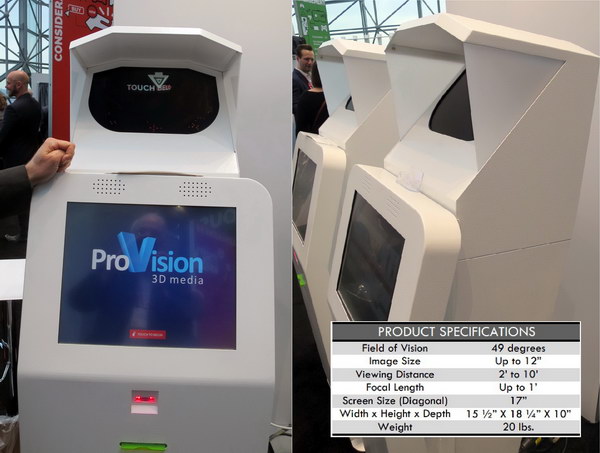 Front and side views of a ProVision kiosk. Even on a cloudy day, the display was difficult to view in the bright environment of the NRF Innovation Lab. Insert: Specifications for the ProVision HL 17 display. (Credit: M. Brennesholtz, insert: ProVision)
Front and side views of a ProVision kiosk. Even on a cloudy day, the display was difficult to view in the bright environment of the NRF Innovation Lab. Insert: Specifications for the ProVision HL 17 display. (Credit: M. Brennesholtz, insert: ProVision)
The ProVision system creates a floating virtual image for advertising applications. On the sunny day, it was virtually unviewable and I was completely unable to photograph it. I went back on a cloudy day and not only got a usable photograph, I also had a chance to talk to the ProVision Founder, Chairman and COO, Curt Thornton.
ProVision describes its technology as “3D Holographic Media” but, not surprisingly, it is neither 3D nor holographic. Still it projects an easily viewable and realistic floating image and ProVision says it has eight patents on the aerial image system, plus trademarks and foreign patents.
In the photo, the ProVision floating image display is the top portion and the lower portion is a conventional kiosk with a touch screen display. The division between the ProVision display and the kiosk is visible as a seam in the side view of the kiosk. Thornton told me the company can build the case of the ProVision display to match the style and color of any kiosk. He also said that ProVision has about 700 of their displays currently deployed in Rite Aid stores and has a contract to add their displays to the existing 17,000 Coinstar kiosks. Shipping to Coinstar began last month and will continue into the foreseeable future. He said Coinstar, whose kiosks are mostly in existing retail stores, is planning on using the displays for in-store advertising of a variety of products and will be a separate profit center than the coin counting machines they are mounted on.
ProVision makes three different sizes of its floating image display, 17”, 29” and 40”. The 17” display, as shown in the photo, is generally used to mount on top of kiosks. The larger versions of the display are often used free standing, for example, hanging on a wall. Typically, the larger unit would be for in-store product promotion, not for advertising networks such as the Coinstar system.
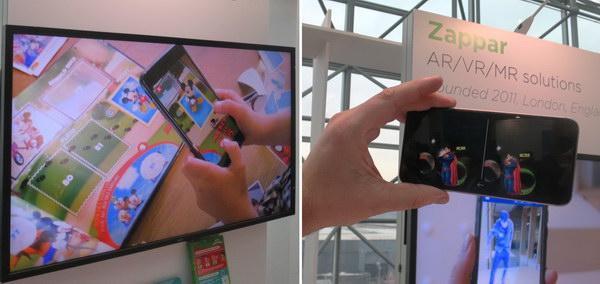 Zappar AR and VR apps. The VR app is intended to be viewed using a Google Cardboard HMD or other smartphone based VR system. (Credit: M. Brennesholtz)
Zappar AR and VR apps. The VR app is intended to be viewed using a Google Cardboard HMD or other smartphone based VR system. (Credit: M. Brennesholtz)
Zappar was showing its AR and VR applications in the Lab. Neither was particularly innovative but they might have been new to the retail community. In the AR application, a smartphone or tablet camera would be aimed at a brochure or other printed matter and, with the Zappar app activated, a cartoon character would appear superimposed on the object’s image. With the Zappar VR technology, a brand could put a printed symbol in its packaging. This symbol could activate the VR app on a smartphone and the user could see the associated VR content using a Google Cardboard or other smartphone based VR system. Ho-Hum.
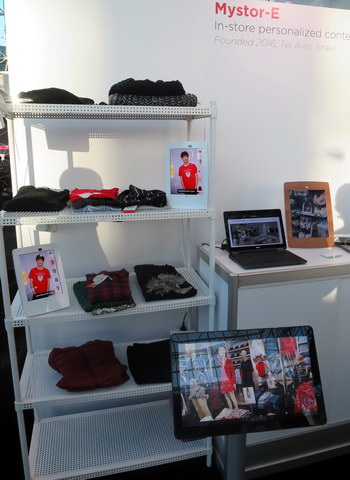 Mystor-E shows personalized product information based on facial recognition and data analytics. (Credit: M. Brennesholtz)
Mystor-E shows personalized product information based on facial recognition and data analytics. (Credit: M. Brennesholtz)
Mystor-E is an Israeli startup that brings e-commerce experiences into brick & mortar stores, enabling retailers to tell relevant and personalized stories to their customers. I talked to Roy Dror, co-founder and COO of Mystor-E, and he said the company will replace the printed signs on product displays with electronic signs. Then, using facial recognition and analytics, when a potential customer approaches the display, he or she is shown products in the display or nearby he is likely to buy, including information on prices, sizes and colors available.
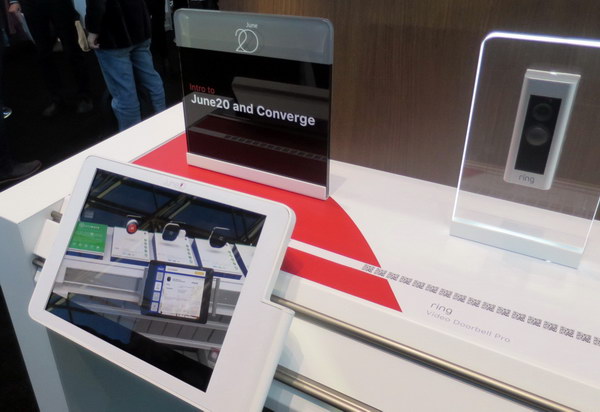 The June20 System. Converge and other June 20 products use the same hardware and differ only in the software and application. (Credit: M. Brennesholtz)
The June20 System. Converge and other June 20 products use the same hardware and differ only in the software and application. (Credit: M. Brennesholtz)
June20 was displaying its rail-based consumer information system for retail applications. this system matches physical items on display with digital content related to them. Paul Chapuis, founder and CEO of June20 demonstrated the system to me, explained how it worked and said what it could do.
An iPad was mounted on a base that slid easily and smoothly along the rails. QR codes were printed on the base beneath the physical objects identifying what object is in a given position. The QR code is read by the camera in the iPad, which then displays the desired information. Using the iPad’s touch screen, users could call up additional information about the item and compare it to similar items of different brands that were also displayed along the rail. Multiple copies of the QR code ensured the consumer didn’t need to position the slider too accurately. The rails were about 8’ (2.4M) long and the system could easily accommodate eight or more different products.
June20 says that the unit is particularly useful in retail locations where the store carries competitive products because it allows the consumer to easily compare the different units – more easily than finding each one on the shelf and comparing the boxes or printed signs. The system is currently installed in several Home Depot locations for evaluation. Home Depot is using it to allow customers to easily compare “smart home” products from different vendors.
 A perfume display with a Perch Interactive IR touch system. (Credit: M. Brennesholtz)
A perfume display with a Perch Interactive IR touch system. (Credit: M. Brennesholtz)
Perch Interactive was in the Startup Pavilion and specialized in using touch and vision systems to determine which product on display the customer was interested in. Trevor Sumner, CEO of Perch, gave me a booth tour. One example of the company’s technology was in my Display Daily for January 24, published elsewhere in this issue.
Another example is shown above. In this perfume display, when a customer reached for a bottle of perfume, the IR touch system determined which bottle the customer was reaching for. The LCD screen behind the perfume would then display an image suggesting what that perfume would smell like. For the example in the image, the system is displaying peonies to indicate the type of perfume. Sumner said while it is easy to show colors of makeup, it is much more difficult to indicate to a casual viewer what a perfume would smell like, which is why Perch is using this flower approach.
There were several other demonstrations that did not involve touch systems. In these demos, several high-value items like handbags were lined up and watched by a machine vision camera. When the customer picked up an item, additional information about it was provided. If the customer put it down in a different position, the system tracked where each item was.
While two of these three examples, plus similar demos from other suppliers, are from the cosmetics industry, Sumner showed me data that indicated the use of Perch’s technology lifted sales for beverages (50%), electronics (81%), gifts (144%), accessories such as handbags (39%) and pet supplies (16%). He also said that research from the University of Ohio indicated the shoppers who touch products are 40% – 60% more likely to buy them than shoppers who just look.

